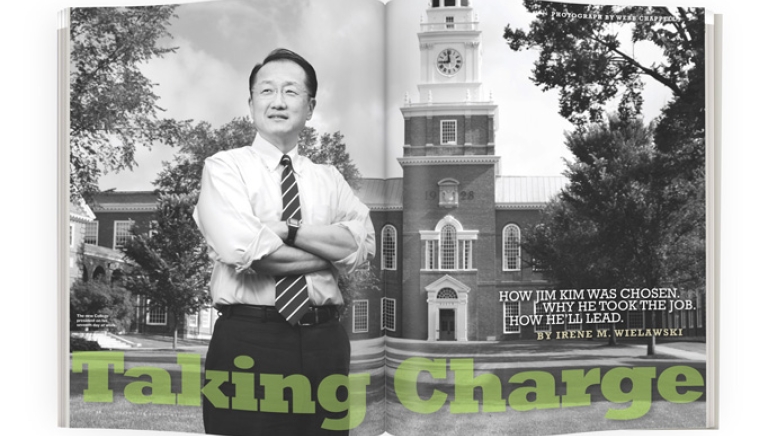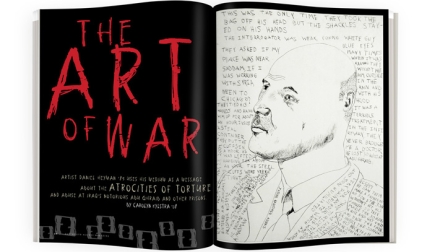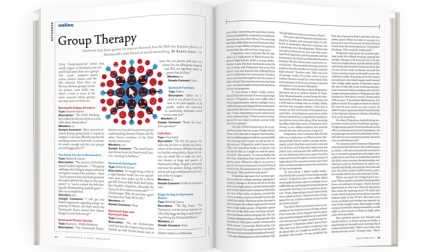Ever since the March 2 announcement that Jim Yong Kim would become Dartmouth’s 17th president, speculative chatter has coursed through academic and healthcare circles. The global health crowd wonders why Kim chose Dartmouth over leadership posts in infectious diseases and healthcare delivery—and the Obama administration, which considered him. Academicians note his atypical resume for a college president. Among alumni and students questions continue to circulate: How was he chosen? Why did he accept? What are his goals? How will the College change under Kim’s leadership?
Kim has touched on the answers in many public and private forums. He’s met with Dartmouth alumni, faculty, administrators, students and prospective students. He’s given numerous interviews, and his comments about Dartmouth’s assets, legacy and potential have been widely viewed on YouTube and other sites.
Listening to these speeches could easily convince one that Kim’s lifelong goal was not just to lead a college but, singularly, to be president of Dartmouth. His excitement is that genuine and, by the accounts of many, contagious—even off campus. A June event in Boston at which Kim was introduced to alumni and parents attracted 450 people, the largest crowd in memory for a presidential event.
Even as medical school commencement speaker and honorary degree recipient last May at his alma mater, Brown University, Kim wove in a reference to John Sloan Dickey ’29, Dartmouth’s president from 1945 to 1970. In exhorting the 90 newly minted doctors to use their education and skills to serve the greater good, Kim quoted Dickey’s maxim, “The world’s troubles are your troubles,” then proceeded to answer the question that even there hung in the air.After all, Brown was honoring Kim based on his accomplishments as a global health physician. What kind of career move was this detour to Hanover?
Kim’s answer was unequivocal: “It is the greatest privilege of my life.”
In a wide-ranging interview in June as he wrapped up his global health work at Harvard, Kim crisply ticked off the things that convinced him to take his new job, especially the undergraduate college with what he describes as some of the smartest young people on the planet taught by talented faculty dedicated to undergraduate education. “This is rare and precious,” says Kim. “I don’t think there’s another college or university where I’d want to be president.”
He also cited Dartmouth’s graduate and research institutions—Tuck School, Thayer School of Engineering, Dartmouth Medical School and Dartmouth Institute for Health Policy & Clinical Practice—as well as the College’s beautiful and largely cloistered setting, which—as Kim sees it—enables students to spend four years intensely engaged in their studies, faculty and peer interactions and social organizations. Kim includes in this last category clubs, arts groups, student government and publications, environmental and political organizations, the College’s extensive sports programs, and the fraternities and sororities that he and his pediatrician wife, Younsook Lim, and their two young sons will live among when they move into the president’s house on Webster Avenue. (For the time being Kim is camped out in an apartment while the president’s house undergoes a renovation that will, among other things, make it fully accessible to those with physical limitations as well as wired for 24/7 teleconferencing.)
“It is a phenomenal environment for learning and scholarship,” says Kim of the College.
But Kim will also tell anyone who asks—he actually made a point of it in his speech at Brown—that being a college president never crossed his mind until he started talking to the Dartmouth search team last fall. And while his enthusiasm and graceful demeanor has been widely reported and commented upon—he listens respectfully, he doesn’t shout or strut, he’s egalitarian and keenly interested in new ideas—it would be a mistake to underestimate the strategic thinking he brings to any decision.
The evidence of Kim’s career shows him to be a man of steely resolve: ambitious, willing to challenge the status quo and unwavering in the pursuit of goals. He comes to Dartmouth deeply serious about the mission the trustees have handed him: to build, in Kim’s words, “the highest quality, most extraordinary undergraduate education the world has ever seen.”
That Kim lacks the resume of a typical college president, with stints in deanships and administrative posts, is largely irrelevant, former colleagues say.
“Jim is a very unusual person in that he is both an anthropologist and a physician, with the broadest possible worldview but also great expertise in his field and the ability to stimulate curiosity in students,” says the Bill & Melinda Gates Foundation’s William H. Foege, Kim’s global health colleague and former director of the U.S. Centers for Disease Control and Prevention. “There aren’t many people who are good researchers, good clinicians and good teachers.”
Also off point, say people who know Kim, are the headlines that have sought to compartmentalize him as the first Asian president of an Ivy League college, a world-health pioneer, an advocate for the poor, a tuberculosis (TB) expert. Indeed Kim is every one of these things, but more significantly he is someone who consistently steps off paths hedged by conventional definitions of success to seek ever-broader intellectual challenges.
“People think of me as a global health person, but it’s just one part of what I do,” Kim says. “A lot of what I’ve done with AIDS and TB has more to do with being an anthropologist than a physician. My interest in infectious diseases is not so much the biology as the way infectious diseases lead to an understanding of poverty and its effects. Lately I’ve been looking at business models—how can we better apply marketing, strategy and operational management to make people better off? Because around our most cherished social goals—health, the environment, a mother’s ability to feed her child—we’ve tolerated horrifically bad execution. It’s inexcusable.”
The process that united Kim and Dartmouth was remarkable both for its serendipity and the way the parties came to share common purpose.
The College began its search for a new president in spring 2008 following Jim Wright’s announcement that he would retire as of June 30, 2009. The trustees engaged John M. Isaacson ’68, president of Isaacson, Miller, a Boston-based search firm that specializes in recruiting executives for nonprofit organizations, notably colleges and universities. In an interview Isaacson described the process that eventually led to the trustees’ unanimous selection of Kim as one of “definition, discovery and learning.”
The definition part—what exactly did Dartmouth want from its next president?—was the most arduous, Isaacson says. Besides meetings with faculty, students, alumni and other constituencies, it included focused research on characteristics of successful academic leaders, according to the head of the search committee, trustee Albert G. Mulley Jr. ’70, chief of general internal medicine at Massachusetts General Hospital and an associate professor of health policy at Harvard’s medical school. From these early soundings emerged a 25-page document, “The Opportunity for Leadership at Dartmouth,” that was given to each candidate. (To view, go to www.dartmouth.edu/presidentsearch.)
The document is remarkable for the fervor with which it states Dartmouth’s historic achievements, purpose, ambition and expectations of its 17th president. Sections are set off by quotes from Dartmouth presidents and alumni. Daniel Webster, class of 1801: “It is, Sir, as I have said, a small college. And yet there are those who love it!” Ernest Martin Hopkins, class of 1901 and president, 1916 to 1945: “Education is not with what men shall do, but with what men should be.” Richard Hovey, class of 1885 and composer of the College alma mater: “Tho’ ’round the girdled earth they roam, Her spell on them remains.” And, of course, the Dickey quote repeated at the Brown medical school commencement.
The narrative of the document employs similarly stirring language: “The next president of Dartmouth will build on a rich tradition and an impressive trajectory. Through the generations, Dartmouth recruited and educated leaders and it preached intellect, virtue and courage. Even as it has retained its commitment to teaching, to building character and to personal transformation, the College has placed new importance on the task of personal learning by fostering partnerships between students and faculty for research and independent study, intuitively understanding that the future belongs to leaders who are inspired, creative and unafraid.”
According to Mulley and trustee chair Charles E. “Ed” Haldeman Jr. ’70, the tone was intentional; trustees did not want candidates looking simply to notch a college presidency. In crafting it, Isaacson and the search committee used actual phrases that alumni, faculty and students had said or written to make their hopes and expectations known.
“We wanted to stop, look, listen and learn as much as we could from all the constituencies of Dartmouth, so we put up a Web site that had literally thousands of postings,” Mulley says. “The language [in the “Opportunity for Leadership” document] about Dartmouth’s legacy of forming leaders and about people going forward with inspiration and courage came from there. We were trying to capture the spirit of the dialogue, but we were also trying to put something out there that would attract people who had demonstrated that they personally were committed, inspired and unafraid.”
Kim’s name did not even appear in the database of prospective college presidents that Isaacson’s firm keeps and turned to in the early stages of the Dartmouth search.
Kim had returned to Harvard in December of 2005, after three years in Geneva with the World Health Organization, where he’d revolutionized international policy on multi-drug resistant tuberculosis (MDR-TB) and greatly expanded the number of AIDS patients receiving antiviral therapy in poor countries.
For these accomplishments and his longtime work with Partners in Health, the visionary international health organization that Kim cofounded in 1987 with Paul Farmer and Ophelia Dahl and which was featured in Tracy Kidder’s 2003 book, Mountains Beyond Mountains, Kim had received a MacArthur “genius” fellowship in 2003. He also was elected to the prestigious Institute of Medicine of the National Academy of Sciences.
In quick succession U.S. News & World Report named Kim one of America’s 25 best leaders and in 2006 Time magazine listed him as one of the 100 most influential people in the world. Harvard, for its part, bestowed not one but three department chairmanships: director of the Francois-Xavier Bagnoud Center for Health and Human Rights at the Harvard School of Public Health, chair of the department of global health and social medicine at the medical school, and chief of the division of global health equity at Brigham and Women’s Hospital.
Kim was in demand nationally and internationally as a lecturer, serving on numerous advisory committees related to health and poverty and also collaborating with Farmer in designing and teaching an enormously popular undergraduate course on global health. The tight-knit global health community fully expected the 49-year-old physician to take on ever more influential positions in infectious disease treatment and prevention. According to Howard Hiatt, former dean of Harvard’s school of public health and a mentor to Kim, his former student was constantly fielding recruiting proposals from medical schools and elsewhere.
Then Kim, knowing nothing of Dartmouth’s search, met Mulley in September of last year.Although both men were faculty physicians at Harvard, their paths had not previously crossed in the medical school’s maze of divisions, departments, specialties and subspecialties. That first encounter was on a subject of shared interest: how to improve health systems operationally so as to deliver better treatment to more patients.
“This was not connected to the search at all,” Mulley says, “but as I got to know more about him I started thinking how Jim had used his undergraduate education, his medical training and his anthropology studies to tackle some of the most difficult issues globally, and also how he had committed himself and his education in a way that involved some personal sacrifice.” The two men continued to meet. Mulley eventually introduced the topic of Dartmouth and invited Kim to throw his application into the pool.
Kim, for his part, attributes his decision to do so to Hiatt, who advised him to take Mulley’s suggestion seriously, as well as to conversations with other mentors and educators, including Brown president Ruth Simmons. The idea of leading an undergraduate institution intrigued him partly because of his own college experience, which he described in his medical school speech as “the defining experience of my life.” Still, Kim wasn’t sure. Then he read “Opportunity for Leadership” and, he says, was com-pletely “blown away.”
“I’d seen similar [recruiting summaries] and I even went on the Internet to pull up a few from universities that were looking for presidents, just to compare,” Kim says. “They were cursory and full of platitudes; Dartmouth’s was literary! It was so interesting that I began reading further, specifically about past Dartmouth presidents.”
His conversations with Mulley, Haldeman and various alumni clinched his interest, Kim says, recalling alumni who teared up when they spoke of what Dartmouth meant to them and how it had influenced their lives.
According to Hiatt, Kim’s decision to take up Dartmouth’s challenge is consistent with his broad view of education and its applicability in the world—though Hiatt is somewhat rueful about his role in encouraging Kim’s interest.
“It’s a brilliant move on the part of Dartmouth,” Hiatt says. “But you can’t imagine what a severe loss it is to us here at Harvard.”
Born in South Korea, the second of three children, Kim grew up in Muscatine, Iowa, population 22,000, where he distinguished himself at Muscatine High School as valedictorian, president of his class, a point guard on the basketball team and quarterback of the football team. Nevertheless, he says he came to Brown with a chip on his shoulder about being Korean. Despite his family’s collective accomplishments, Muscatine’s only Asian family was not entirely accepted in the community. Stares—and sometimes jeers—were not unusual on trips to the mall, Kim says.
“So in addition to my classes at Brown [where he graduated magna cum laude] I spent a lot of time in the Third World Center with the African American and Latino students where we were constantly debating and trying to come up with a rationale that united us,” Kim recalls. “One of the sillier things we came up with was that all of us liked spicy food. Why? Because our ethnic and cultural roots were in poor countries where people use spices to liven up really dull food—rice, beans and, in my case, kimchi, cabbage.”
Kim recounts this lightly. As an anthropologist he understands the power of personal stories to capture emblematic human experiences and forge connections with people of different backgrounds. But his appreciation goes beyond scholarly interest: Kim is a natural storyteller who has plumbed his experiences as student, teacher, scientist, colleague, social activist, son, husband and father to find stories with universal appeal and the power to drive home a point.
Characteristically, this one about the debates at the Third World Center, though told with perfect comedic timing, has a serious point. The discussions about race with other students of color—and their ultimately fruitless search for a clean divide between whites and nonwhites—enabled him to move beyond introspection to an understanding of his cultural and racial heritage in context, whether the setting was the Third World Center or back home on school breaks where Kim says his late “practical dentist father,” a two-time immigrant and escapee from repressive North Korea, thunderously denounced his son’s penchant for “non-science courses.” Kim has thought a lot more since contemplating the Dartmouth job about his experiences as a college student and the influence of his undergraduate years on the trajectory of his life and career.
“The thing I became aware of was the extraordinary combination of race, culture and class,” Kim says. “I decided to go to medical school for those ‘real skills’ my father wanted for me, but at the same time I decided to study anthropology.”
Kim undertook these studies at Harvard. For his Ph.D. thesis in anthropology, Kim investigated the economic and political role of pharmaceuticals in Korean medical practice—research that required him to travel to South Korea and learn his ancestral language. “What I discovered there was that while I looked like everyone else in Korea, in my head I was American,” Kim says. “I saw things differently. Culture, I realized, was layer upon layer upon layer. I came away from that four- to five-year investment in intensive study largely a universalist.”
This applies professionally as well. His specialized degrees notwithstanding, Kim works hard at being a generalist because, like an antenna searching for signals, he wants to be open to information from all sources, not just science and anthropology but economics, political science, music, literature, languages and the many out-of-classroom activities and experiences that make up a Dartmouth education.
For example, Kim loves sports—both as a player and as an educator. He played competitive volleyball well into his 30s, has recently returned to golf (in which he was once a single-digit handicapper) and, more casually, despite his habitual long work days, says he looks forward to playing Frisbee with students on the Green. By week two of his tenure he had played golf with both students and trustees, teeing off in the rain with students at 5 a.m. for 12 holes before a morning meeting.
Kim is thrilled by the fact that roughly 80 percent of Dartmouth students participate in varsity, club and intramural sports. He also values social organizations, including the fraternities and sororities that are periodically controversial at Dartmouth, as at other colleges. “There’s a ton of evidence that participation in team sports and social organizations nurtures intellect,” Kim notes.
This capacity to seek out and apply useful information from disparate sources marked Kim’s work with Partners in Health to address critical health needs in Haiti and Peru and, later, with the World Health Organization (WHO) to improve TB and AIDS treatment in poor countries.
“Jim really has a rigor for thinking through problems and finding pathways to solutions that no one else sees,” says longtime colleague Ophelia Dahl, executive director at Partners in Health. “There are a lot of door-closers, the people who say: ‘No, I don’t think we can do that.’ ‘No, there’s no funding.’ ‘No, that’s not how we do things here.’ Jim asks the right questions and knows how to advocate and make the case.”
The best way to understand what that means is to take an example from Kim’s past: his successful challenge to business as usual at WHO with regard to MDR-TB.
MDR-TB can be cured only with special drugs that have historically been priced out of reach of poor countries. WHO officials had long accepted the drug prices as a given, and from this assumption flowed a policy that essentially abandoned poor patients with this lethal strain of TB.
Shocked by the equation’s utilitarian brutality, Kim questioned why the price had to be a given. After determining with his research team that all but one of the MDR-TB drugs lacked patent protection yet still were priced hugely above the cost of production, Kim recast price not as a given but as an X variable and through a complex market strategy negotiated price reductions of as much as 90 percent.
His approach to this problem can’t be described as purely medical or anthropological, and it certainly wasn’t grounded in conventional global health thinking. The drivers of his analysis came from the academic disciplines of economics, political science and mathematics.
The implications are many as Kim begins his examination of givens and potential variables at Dartmouth. Kim has repeatedly asserted that he intends to begin slowly in order to learn from as many constituencies as possible and to familiarize himself with the College’s operating structure. But people who know him well say the wait for action is not likely to be long.
“Jim’s analytical approach is evidence-based, and once the evidence is there he is decisive and acts boldly,” says Arthur Kleinman, a psychiatrist and professor of medical anthropology at Harvard who has known Kim since he was a medical student.
What changes might be in store for Dartmouth are impossible to predict at this point. The first crop of freshmen under Kim’s tenure has yet to arrive for first-year trips. But there are clues. For one thing, Kim is a sharp critic of prevailing approaches to diversity at colleges and universities because they overlook the fundamental role of cultural identity in how people see the world and apply their intellect and creativity. He cites, among other examples, the largely racially based method of measuring and describing population mix—black, white, Asian, Hispanic—and the prevalence of “political correctness” which, according to Kim, stifles honest engagement and hides issues that ought to be aired.
“The way we deal with diversity on American campuses is so superficial that it is dangerous,” Kim says. “The worst of it is that smart young people can see through the superficiality and conclude that diversity is not important or that the shallow, stylized way we deal with cultural competence is sufficient. It is not. In the end we have to understand each other’s humanity.”
Kim has great faith in the ability of undergraduates to grasp that humanity and believes the undergraduate years are the most fertile for inculcating in students a broad worldview, confidence in their ability to surmount obstacles and the capacity for informed risk-taking—all attributes of leaders.
The scientist in him makes the case biologically: 18- to 22-year-old brains are still developing, the myelin is not all there and the neural pruning that leads to streamlined—but also more cautious—adult thinking isn’t complete. Parents, teachers, administrators and Dartmouth’s Safety & Security staff are very familiar with the downside. This age group tends to leap before it looks. But their openness of mind to ideas, to new ways of doing things and to people not like themselves, far outweighs deficits in maturity. It’s one of the reasons Kim says he and Farmer explicitly chose to create and teach a global health course at Harvard for undergraduates, despite their heavy teaching and mentoring loads at the medical school level and an institutional emphasis on graduate students.
“What a place like Rwanda or some other poor country needs more than anything else is people willing to take the steps necessary to understand Rwanda and the Rwandan people on their own terms and to identify solutions within that framework,” Kim says. “This requires a strong liberal arts education to achieve the suppleness of mind necessary to creatively use what’s available. At the end of four years students should be shot out into the world with vision, passion, humility and determination no matter how they choose to use their education.”
Kim’s speeches are replete with references to all that Dartmouth has to deploy toward this goal. But he’s also demonstrated in his global health work and his teaching and research at Harvard that he’s a stickler for execution. At Dartmouth this is certain to play out broadly, whether the issue is campus life, alumni affairs, technology or how scholarly ideas are translated in the classroom.
“We have to identify the areas of excellence at Dartmouth but we also have to look at other campuses and capture their best ideas,” Kim says. “And we have to be willing to experiment—to test our best hunches and see what happens. Are we being as effective as we can be at turning on young peoples’ intellect and curiosity? Are there teaching techniques that encourage students to operationalize what they learn, essentially helping them to experience leadership?”
That’s a sampling of the directions in which Kim is likely to move Dartmouth, though by no means comprehensive. Indeed, Steven Kadish, a longtime public health administrator who helped Kim operationalize goals at Harvard and now is Kim’s strategic advisor at Dartmouth, says they have a standing joke: “Only one new idea per day.”
Irene M. Wielawski is a freelance journalist who lives in Pound Ridge, New York.




